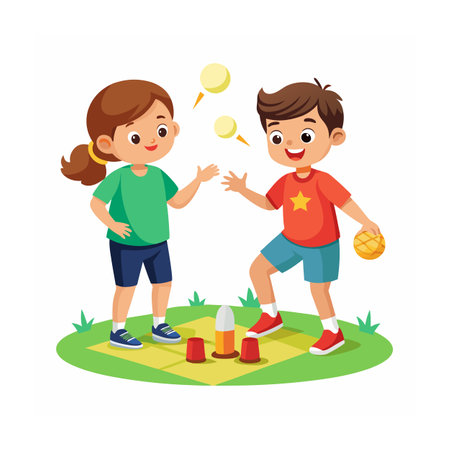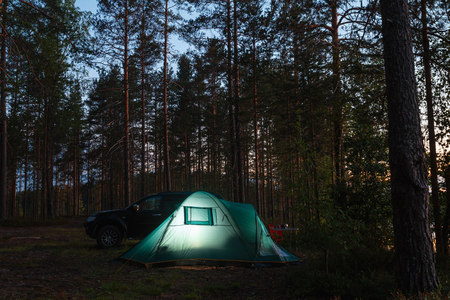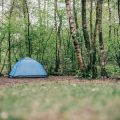1. Choose a Family-Friendly Campsite
When youre camping with kids, the first step to a safe and fun experience is picking the right campsite. Not all campgrounds are created equal, so its important to choose one that’s designed with families in mind. Look for spots that offer features making it easier to keep your little adventurers safe and happy.
What Makes a Campsite Family-Friendly?
Here are some key things to look for when selecting your campsite:
| Feature | Why It Matters |
|---|---|
| Flat Terrain | Makes it easier for kids to walk and reduces tripping hazards. |
| Clean Restrooms | Essential for hygiene and convenience, especially with young children. |
| Designated Fire Pits | Keeps fires contained and helps teach kids about fire safety. |
| Safety Signage | Warns of local wildlife, hazardous areas, or rules that help keep everyone safe. |
Consider National Parks and Established Campgrounds
National Parks and well-maintained campgrounds often have family-friendly amenities like ranger programs, nature trails, playgrounds, and even junior ranger activities. These places are great choices because they’re usually patrolled regularly and have clear rules that promote safety for all guests.
Pro Tip:
Before you book, check the campgrounds website or call ahead to ask about kid-specific features. Some sites even offer family-only sections or quiet hours that help ensure a more relaxed environment for parents and children alike.
Quick Checklist for Parents:
- Is the site flat and free from hazards like cliffs or fast-moving water?
- Are there clean bathrooms nearby?
- Are fires restricted to designated pits?
- Is the area marked with clear signs about safety rules?
- Does the site offer family-friendly programs or activities?
Selecting the right campground sets the tone for your entire trip. With a little research, you can find a spot that keeps your kids engaged—and most importantly—safe during your outdoor adventure.
2. Set up a Safe Camp Layout
When youre camping with kids, how you set up your campsite matters more than you might think. A well-organized layout can help prevent accidents and give your little ones room to explore safely. Think of it like baby-proofing your home — only outdoors. Here are some key tips to keep in mind as you design your camp setup.
Keep Cooking Areas Separate
Camp stoves, grills, and open flames should always be kept away from tents and play areas. Not only is this safer, but it also helps avoid smoke blowing into your sleeping space. Create a designated cooking zone and make sure kids understand its off-limits unless supervised.
Recommended Distance Guidelines
| Area | Minimum Distance from Tent |
|---|---|
| Campfire or Fire Pit | 15 feet |
| Portable Grill or Stove | 10 feet |
| Food Prep Table | 8 feet |
Create Clear Boundaries for Kids
Kiddos love to wander, so setting clear limits is key. Use natural barriers like logs or rocks to mark play zones, or bring along colorful flags or cones to outline safe areas. This not only keeps them within sight but also gives them a sense of ownership over their “kid zone.”
Kid-Friendly Boundary Ideas:
- Bungee cord lines: Stretch between trees to create visual borders.
- Pennant flags: Easy to spot and fun for kids.
- Tarp mats or blankets: Define sitting or play areas on the ground.
Block Off Dangerous Spots
If you have a fire pit or other hazards nearby, take steps to block access. You can use folding camp chairs, coolers, or even extra gear bags as temporary barriers. Just make sure they’re stable enough that curious toddlers can’t easily move them.
A Few More Safety Tips:
- Avoid setting up tents near steep drop-offs or water sources.
- If possible, place tents in a semicircle so adults can always see the kids’ tent.
- Add solar lights around tripping hazards like tent stakes and guy lines.
A safe camp layout doesn’t just protect your children — it gives you peace of mind and lets everyone enjoy the outdoors with fewer worries.

3. Secure Gear and Hazardous Items
When camping with kids, one of the most important safety steps is keeping dangerous gear and supplies out of reach. Curious little hands can quickly get into trouble if sharp tools or fire-starting equipment are left accessible. Heres how to secure your campsite properly:
Store Dangerous Items Safely
Keep all potentially hazardous items stored in locked bins or placed well out of childrens reach. This includes:
| Item | Storage Recommendation |
|---|---|
| Knives, axes, and other sharp tools | Locked plastic bin or hung high on a tree hook |
| Stoves and fuel canisters | Stored in a locked box when not in use |
| Lighters and matches | Secured in a waterproof, lockable container |
| Food and scented items | Bear-proof container or vehicle storage where allowed |
Make the First Aid Kit Accessible to Adults Only
Your first aid kit should be within easy reach for adults but out of reach for children. Store it in a visible spot inside the tent or under a designated chair, so you can grab it quickly if needed.
Use Bear-Proof Containers Where Required
If youre camping in bear country, using bear-proof containers isnt just about wildlife safety—its also crucial for child safety. These heavy-duty containers keep food secure and prevent curious kids from getting into snacks they shouldnt touch or play with.
Quick Tips:
- Label bins clearly so adults can find items fast.
- Teach kids not to open any storage boxes without permission.
- Create a designated “kid-safe zone” away from cooking and tool areas.
By taking these simple steps, youll create a safer campsite environment that helps prevent accidents and gives you peace of mind while enjoying the outdoors with your family.
4. Establish Safety Rules with Your Kids
Before you even pack up the car, its important to talk to your kids about campsite safety. Setting clear and simple rules can help prevent accidents and give everyone peace of mind. These conversations should happen both before the trip and throughout your camping adventure.
Start the Conversation Early
Kids get excited about camping, so use that excitement as a chance to talk about safety in a positive way. Frame rules as part of the fun—not just restrictions. For example, explain how staying close helps everyone enjoy the trip more.
Key Safety Topics to Cover
Focus on a few essential rules that are easy for kids to understand and remember. You can even write them down or make a fun checklist together.
| Rule | Why It Matters |
|---|---|
| Stay within sight of an adult | Keeps kids from wandering into dangerous areas like rivers, cliffs, or thick woods |
| Don’t touch firewood, grills, or campfires | Prevents burns and injuries from hot surfaces or sharp tools |
| Never approach wild animals | Protects children from potentially dangerous wildlife encounters |
| If you get lost, stay in one place and call out for help | Makes it easier for adults to find them quickly and safely |
Make Safety Fun and Memorable
You can turn safety talks into games or role-play scenarios. For example, play “What Would You Do?” where you ask questions like: “What would you do if you saw a raccoon near the tent?” This helps reinforce learning in a non-scary way.
Use Visual Reminders
Create small signs or bring visual cues that remind your kids of the rules. A sticker chart on the cooler or a rule poster inside the tent can be great reminders throughout your stay.
Keep Reinforcing Daily
A quick morning review of safety rules each day can go a long way. Make it part of your routine—just like brushing teeth or putting on sunscreen.
By involving your kids in setting and remembering these safety rules, youre not just keeping them safe—you’re also helping them become responsible campers who respect nature and know how to enjoy it safely.
5. Keep Nighttime Safe and Comfortable
Once the sun goes down, your campsite can become a maze of shadows and tripping hazards—especially for kids. Making your campsite safe and cozy at night is key to a stress-free camping experience with little ones.
Light Up the Night
Proper lighting helps prevent trips, falls, and nighttime anxiety. Heres how you can keep things bright and child-friendly:
| Lighting Option | Benefits |
|---|---|
| LED Lanterns | Long-lasting, cool to touch, and bright enough for group areas |
| Solar-Powered Lights | Eco-friendly and great for lining pathways or around tents |
| Flashlights for Kids | Personal light source that’s fun and easy to carry |
| Glow Sticks | Safe, battery-free option kids can wear or carry at night |
Create a Cozy Sleep Setup
A good night’s sleep starts with comfort and protection. Make sure each tent is set up to keep bugs out and warmth in:
- Zipped Screens: Always keep tent screens zipped to block bugs and small critters from sneaking in.
- Padded Sleeping Areas: Use sleeping pads or air mattresses to cushion the ground and add insulation.
- Snuggly Bedding: Bring familiar blankets or sleeping bags to help kids feel at home.
A calm, well-lit environment will help your kids feel secure after dark—and help you get some rest too!


